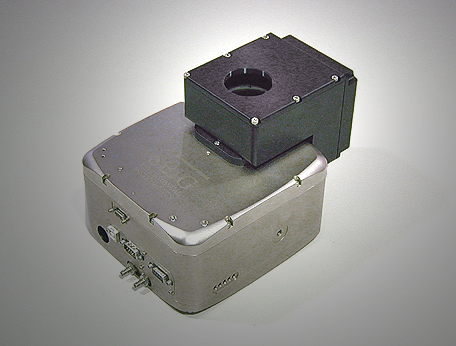 |
Model AO-L Adaptive Optics System Attached to STL Camera |
Models AO-L and AO-8
Adaptive Optics Systems
for STL and ST Cameras
February 28, 2007
Update: August 27, 2007
 |
Model AO-L Adaptive Optics System Attached to STL Camera |
MODELS AO-L and AO-8 ADAPTIVE OPTICS SYSTEMS
The AO-L and AO-8 are second generation adaptive optics systems from SBIG specifically designed to enable an SBIG camera user to obtain the ultimate in image resolution that his/her telescope and site can achieve. The AO-L is designed for the STL series cameras. The AO-L can also be used with any ST-7/8/9/20/2000 USB camera with the appropriate adapter kit. The smaller AO-8 is a replacement for the former AO-7 and can only be used with ST-7/8/9/10/2000 USB cameras. Both of these units get power and commands directly from the camera via a short cable to camera's I2C port. No other external cables are required for power or control. Both units have an I2C output port as well so they are fully compatible with other I2C accessories that you might add to the system, such as a filter wheel or our soon to be released autofocuser.
TIP-TILT HIGH SPEED GUIDING
SBIG has exploited the second guiding CCD detector in our self-guiding cameras to stabilize stellar images, enhancing resolution. These new AO systems use a tip-tilt transmissive element to correct for image wander due to low order local atmospheric effects and for correction of mount errors, wind vibration and other erratic motion of the optical system that is otherwise too fast for an autoguider or telescope drive corrector to respond to effectively. By monitoring a guide star with the smaller tracking CCD that is built-in to SBIG cameras, or the Remote Guide Head, the AO makes fine corrections at approximately 10 times per second to hold the image fixed on the CCD during the exposure.
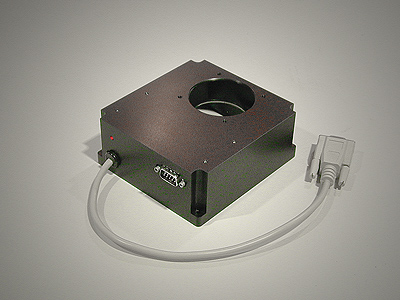 |
Model AO-8 Adaptive Optics for ST series cameras |
The system is closed loop, which means that it checks the position of the guide star after every move and makes adjustments on the next move. This results in a series of small, fast and very precise moves that continue over the course of a long exposure. This is possible because the guide chip is located behind the AO device and can measure the results of each move it makes. In the past, with the AO-7, this presented some difficulties when using narrow band filters because light from potential guide star candidates was attenuated by the narrow band filter to one degree or another resulting is guide stars that could be difficult to find or too dim to use. However, the new AO design and new camera improvements eliminate this problem. Because of their more compact design, the new AO systems lend themselves to the use of off-axis guiders that can place a pick-off mirror or diagonal in front of the filter wheel. Also, all new USB cameras support a Remote Guide Head that essentially places the on-board guiding CCD anywhere in front of the filter wheel the user decides and this Remote Guider duplicates all the functions of the built-in tracking CCD, including the fast readout function required to control the AO. This means that by using a custom off-axis guider, one can still have all of the benefit of the AO no matter what filter is being used, even filters that make starlight nearly invisible to the imaging CCD. The image below shows the AO-L with such an off-axis accessory attached. In this case it is an Astrodon MOAG which allows the Remote Guide Head to be used in front of the filter wheel.
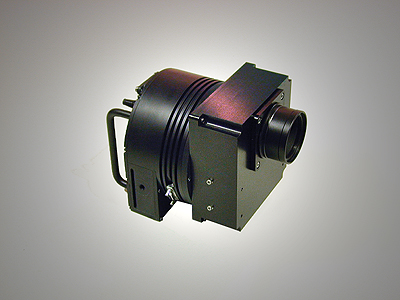 |
Model AO-8 Adaptive Optics System Attached to ST Camera |
Another benefit of the new AO design is that they
take up far less backfocus. The former AO-7 required about 3.5 inches of backfocus
and placed the camera at right angles to the optical system. Inserting an off-axis
guider or other pick-off mechanism added even more backfocus. However, the AO-L and
AO-8 require only about 2 inches of backfocus (when attached directly to the camera) and
leave the camera square in the optical path. Additionally, the transmissive element
of the new AO design has a relatively large range of motion. In the AO-8 for
example, the range of correction is roughly +/- 40 pixels. Assuming one is imaging
at approximately 1 arcsecond per pixel, this means the AO-8 can correct for up to about 40
arcseconds of periodic error in the telescope mount. Since most modern mounts with
PE error correction are capable of reducing any residual periodic error within this range,
it is possible to guide long exposures with the AO-8 without making any guiding
corrections to the mount at all. Guiding in this manner is also far more accurate
than can be achieved by issuing corrections to the telescope drive. The tilt of the
element during operation does not lead to any image rotation or measurable defocusing at
the edges of the frame, even when relatively large ranges of correction are required from
beginning to end of the exposure. If the image drifts slowly during the exposure due
to Periodic Error or slight misalignment of the mount, the AO can continue to operate
without having to issue any corrections to the mount to re-center the guide star.
This larger range of motion is one more advantage of the AO-8 over the earlier AO-7 design
which worked best when making corrections within a narrower range, requiring mount
calibration and interaction.
The AO-8 systems can be installed by the user to any dual sensor ST-7/8/9/10/2000 USB cameras. The AO-L can be installed by the user to any STL camera, and to any dual sensor ST-7/8/9/10/2000 USB cameras. A USB camera equipped with the optional Remote Guide Head is required to use either AO with an off-axis guider. This remarkable system has had a profound effect on CCD imaging by reducing the atmospheric turbulence, wind induced vibrations, and eliminating the remaining periodic errors in most telescope drives. Some of the best, high resolution images we have seen produced by amateur astronomers have taken advantage of the AO technology introduced by SBIG.
RESULTS
The results one can achieve with the AO-L or AO-8 depends on a number of factors and no two imaging sites are exactly the same. However, many years of experience with the former AO-7 and now the AO-L make it clear that SBIG's implementation and design of a closed loop AO offers a distinct advantage in image resolution, even when one has superior optics, mount and calm seeing. Take for example the test images below of the same double star captured with and without the AO-L operating. The brighter star is approximately mag 14.7 and the dimmer star is approximately mag 15.7. Separation is approximately 3.7". Two 15 minute images were taken one right after the other on the same night with an STL-11000M-C1 camera through a 20" F/8.3 RC scope mounted on a Paramount. The AO-L image clearly shows a tighter, brighter, better resolved stars compared to the non-AO image. The AO improved the measured FWHM (Full Width at Half-Maximum) and peak brightness of both stars by nearly 30%.
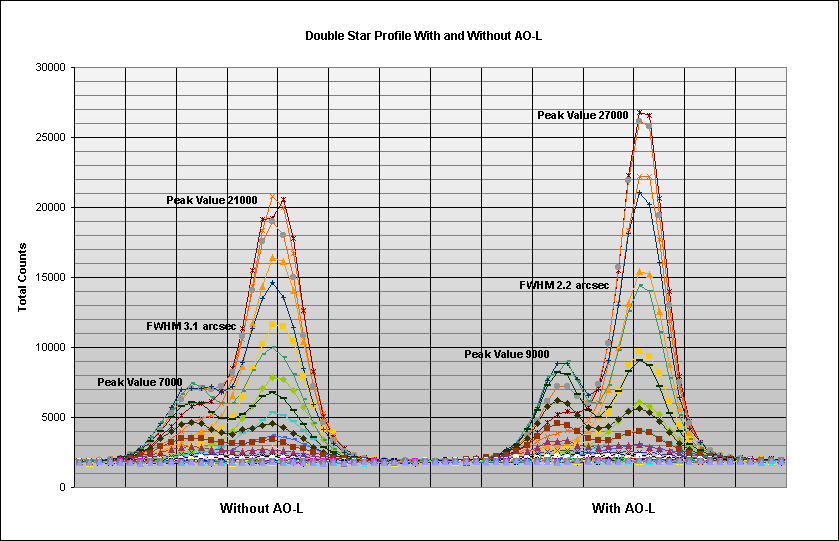 |
|
|
|
Double star image without AO (left) and with AO (right). Both images are 15 minute exposures, enlarged 300% |
|
In the case of a mount with an erratic drive error the results can actually be more dramatic. Some imagers have told us that without the AO it was virtually impossible to obtain high quality images without some star trailing due to the behavior of their mount or drive system. But by adding the AO, it was like upgrading to a nearly perfect mount and drive yielding untrailed star images in long exposures.
The AO-L has been in production for sometime. We will begin making the AO-8 in September and we are now accepting orders for this accessory.
If you have both and STL and an ST cameras and want to adapt the AO-L for use with both types, adapter kits are available for attachment of the AO-L directly to the ST camera body, or to a CFW8A, CFW9, or CFW10.
Beginning in February 2007, SBIG will also offer the Astrodon MOAG accessory for guiding or controlling the AO with the Remote Guide Head from in front of the filter wheel.
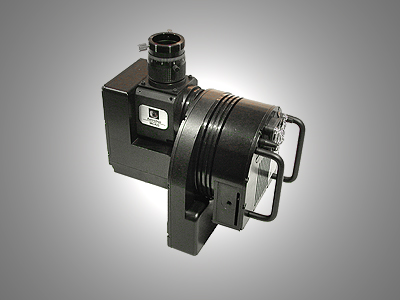 |
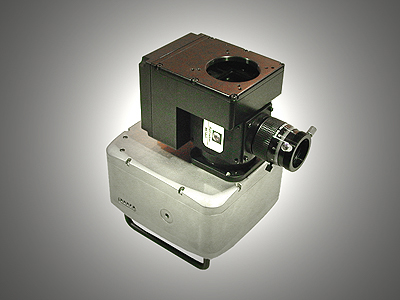 |
AO-L
and MOAG attached to an ST |
AO-L
with MOAG attached to an STL camera |
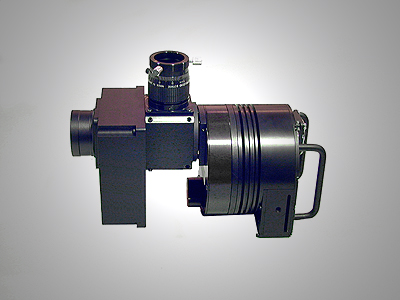 |
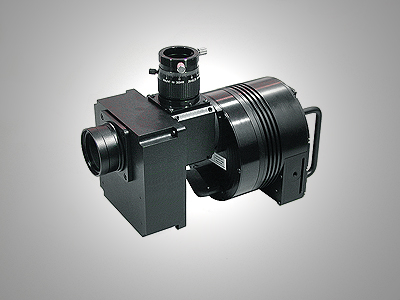 |
AO-8 and MOAG attached to an ST
series with a CFW9 |
|
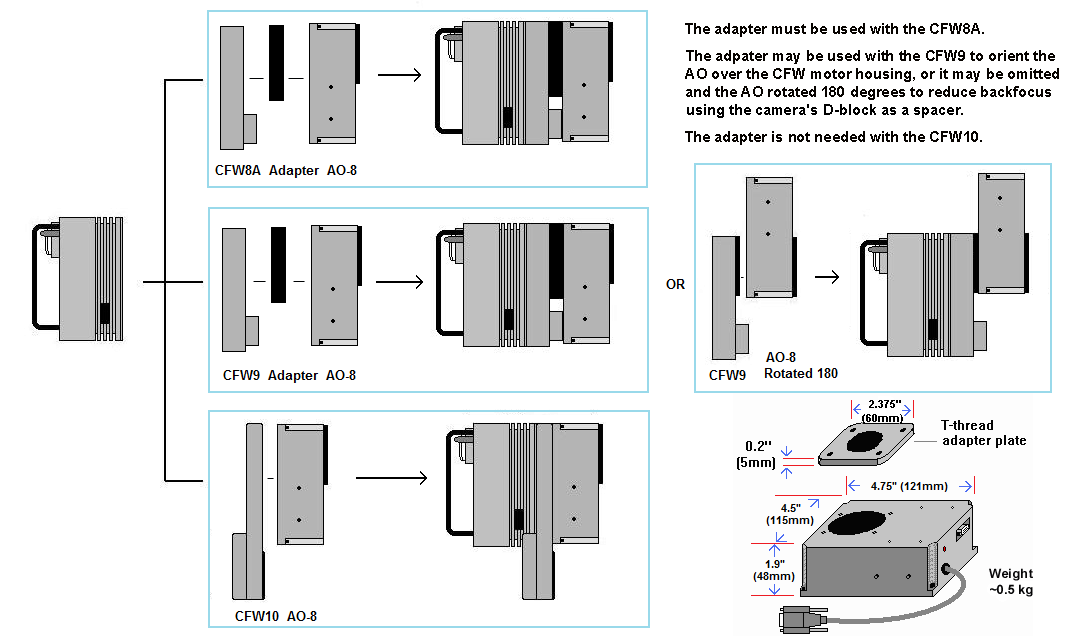 |
|
Model AO-8 Attachment Chart |
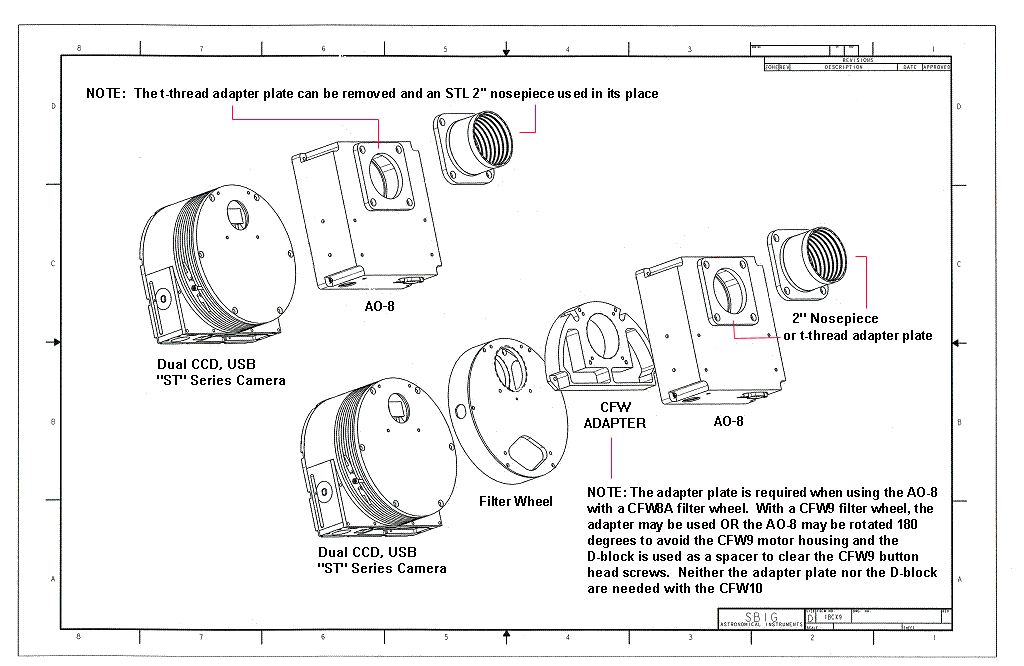 |
AO-8 Manual AO-8 Mechanical Drawing Housing AO-8 Mechanical Drawing Cover Plate
Price and availability
The AO-L and MOAG are available and have been shipping for some time.
The AO-8 is a new product
that begins production in September 2007.
Please check our Price List for the current price at the
time of your order.
Prices and availability are subject to change without notice.
Revised:
April 02, 2008 08:01:39 AM.
Copyright © 2007 Santa Barbara Instrument Group, Inc. All rights reserved.
Please report any problems with this page directly to the Webmaster